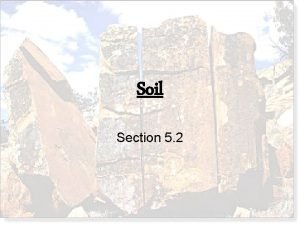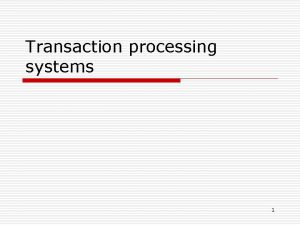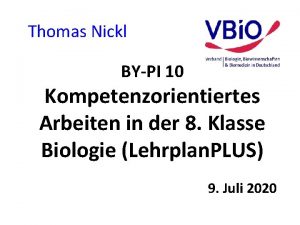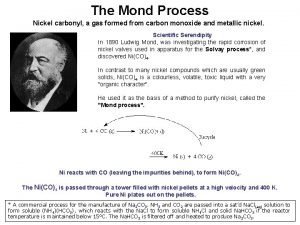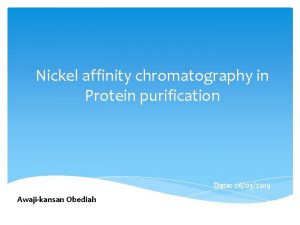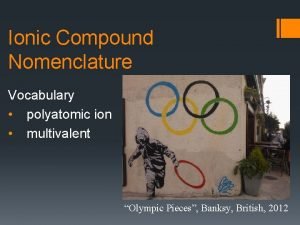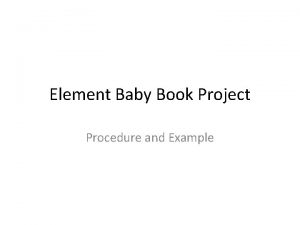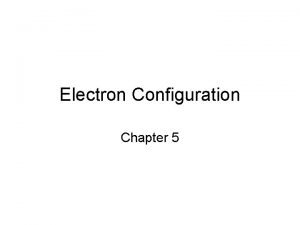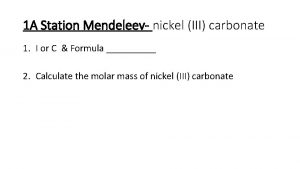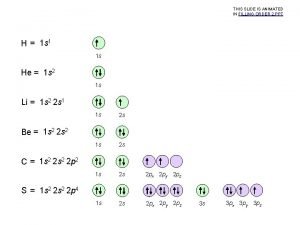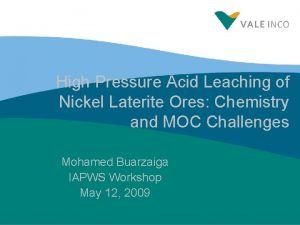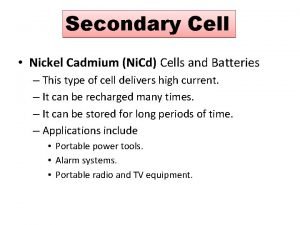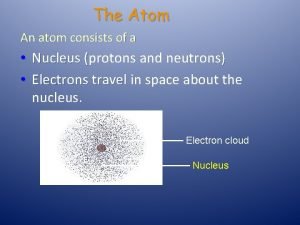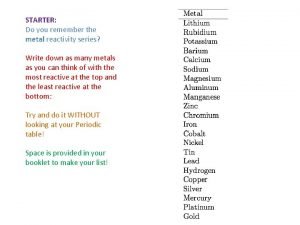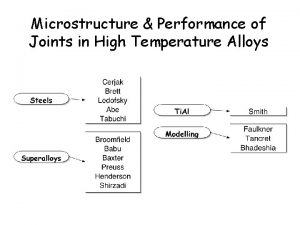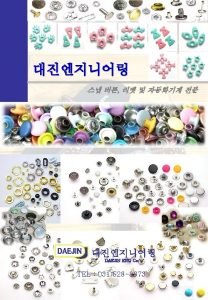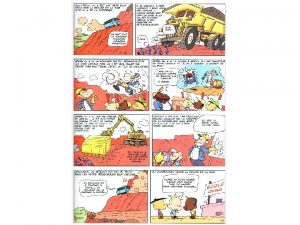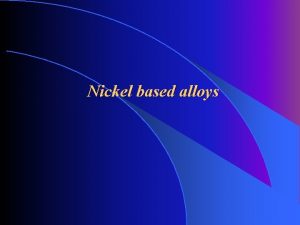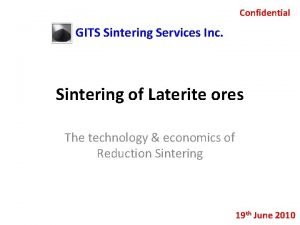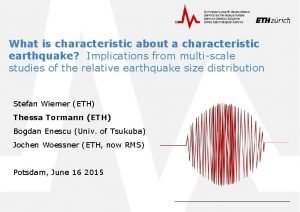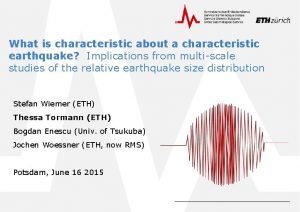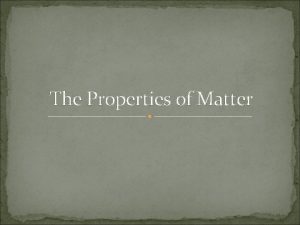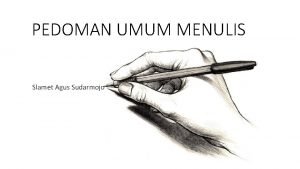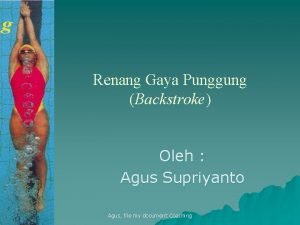Processing Technology vs Nickel Laterite Ore Characteristic Agus


























- Slides: 26

Processing Technology vs Nickel Laterite Ore Characteristic Agus Superiadi PT Inco. Tbk

Presentation Outlines Types of Nickel Deposit World Nickel Mineral Resources Nickel Laterite Development Processing Technology of Nickel Laterite Processing vs Ni Laterite Ore Characteristic Summary

Types of Nickel Deposits Sulphide nickel deposits – Nickel as nickel sulphide pentlandite, millerite – Nickel ores processed through milling and smelting Laterite nickel deposits – Oxide Ni deposits: Ni as hydroxide in the ferruginous zone – Clay silicate deposits: Ni as clay silicate – Hydrous silicate deposits: Ni as hydrous-silicate in saprolite – Nickel ores processed through pyro-metallurgy (smelting) or hydro-metallurgy (leaching)

WORLD’S LAND-BASED Ni RESOURCES Mt Ore % Ni Relative % 0. 58 Contained Nickel Mt 62 SULPHIDES 10, 594 LATERITES 10, 382 1. 32 140 69% TOTAL 20, 976 0. 96 202 100% 31%

WORLD Ni PRODUCTION & RESOURCES PRIMARY Ni PRODUCTION WORLD Ni RESOURCES 60% 70% LATERITE SULPHIDE LATERITE 40% SULPHIDE 30%

LATERITE vs. SULPHIDE DEPOSITS CUBA PHILIPPINES INDONESIA NEW CALEDONIA AUSTRALIA LATERITES SULPHIDES

World Nickel Laterite Deposits Albania Cuba Guatemala Columbia Greece Dominican Republic Ivory Coast Venezuela Burundi Brazil India Ethiopia Burma Philippines Indonesia Zimbabwe Madagascar Australia Producing Countries Non Producing Countries PNG New Caledonia

World Nickel Laterite Resources (Distribution by Contained Nickel) America 8% Africa Other 4% Caribbean 25% 8% Australia 8% Philippines 11% Indonesia 16% New Caledonia 20%

DEFINITION OF LATERITES Nickel laterites are: – Residual soils – Have developed over mafic/ultramafic rocks – Through processes of chemical weathering and supergene enrichment – Under tropical climatic conditions Laterites are source of metals: – Ni, Co, Cr, Fe (from laterites derived from ultramafic rocks) – Al (from laterites derived from aluminous rocks)

Laterisation

LATERITE PROFILE On Unserpentinised Peridotite, Sorowako Red Laterite (Hematite) Yellow Laterite (Limonite) Saprolite zone Bedrock pinnacle

Considerations for developing a nickel laterite project Nickel grade; cobalt grade Resource tonnage / Life of Mine / scale of operation Ore chemistry and mineralogy Upgradeability of ore Process selection Availability of cheap power supply Selection of fuel Availability of raw materials: water, silica flux, aggregate Availability of infrastructure Location of project Mining method Environmental considerations Negotiations with local and central governments Funding of the project Selection of engineer and contractor

PROCESSING OF Ni LATERITES Pyrometallurgical processing (Ore is melted) – Ferro-nickel – Ni-matte – Ni Pig Iron Hydrometallurgical processing (Leaching by acid) – PAL (Pressure acid leaching) – HPAL – AL (Atmospheric Leaching) – Heap Leaching Combined pyro and hydro process (Caron) (Ore is reduced at high temperature, then leached)

Ferro-Nickel Projects in the world Project Owner Country Remarks Cerro Matoso BHP-B Columbia Codemin Anglo Brazil Doniambo SLN/Eramet New Caledonia Exmibal Ex. Inco Guatemala Falcondo Falconbridge Dominican Rep. Fenimark FENI (govt. ) Macedonia Closed Hyuga Sumitomo Japan Imported ore Larymna Larco Greece Loma de Hiero Anglo Venezuela Morro do Niquel Anglo Brazil Closed Oheyama Nippon Yakin Japan Imported ore Onca-Puma Vale Inco Brazil PAMCO Nippon Steel Japan Imported ore Pomalaa ANTAM Indonesia Some imported ore Mothballed Nickel-Matte Projects of the world Project Owner Country Sorowako PT Inco Indonesia Doniambo SLN/Eramet New Caledonia Remarks

HPAL Projects of the world Project Owner Country Remarks Moa Bay Cuba Niquel Cuba First HPAL Australia Shut down Bulong Cawse Norilsk Australia Murrin-Murrin Minara Australia Coral Bay Sumitomo Philippines Goro Vale Inco New Caledonia Under construction PNG Under construction Australia Under construction Ramu River Ravensthorpe BHP-B CARON Projects of the world Project Owner Country Nicaro Union del Niq Cuba Punta Gorda Union del Niq Cuba Nonoc Remarks Philippines Closed Imported ores QNI BHP-Billiton Australia Tocantins Niquel Toc. Brazil

Heap Leach Projects of the world Project Owner Country Remarks Caldag European Nickel Turkey First Heap Leach project Ravensthorpe BHP-B Australia Part of flow sheet Murrin-Murrin Minara Australia Expansion of project Piaui Vale Brazil Being fast-tracked for production

PYROMETALLURGICAL PROCESSING Ferro-Nickel Process Nickel-Matte Process Upgrading in the mine Drying of ore Upgrading after drying Calcining Electric Furnace Smelting Refining Furnace Converting Ferro-Nickel Product 20 – 50% Ni Nickel-Matte Product 78% Ni

PYROMETALLURGY Important concerns: Slag should not attack refractory (S/M ratio) Melting temperature should be suitable (S/M; Fe) Olivine should not be introduced to the furnace Appropriate reduction of ore prior to smelting Ni/Fe ratio in the ore for ferro-nickel operation

HYDROMETALLURGICAL PROCESSING HPAL Process Heap Leaching Process Ore Preparation: wetting, screening, crushing, ore beneficiation Pre Heating through flash steam Heap Formation Pressure Acid Leach in autoclave Heat recovery from leached pulp Acid Dripping Pregnant solution Sequential Precipitation of metals CCD thickening and washing Neutralization Neutralisation of pregnant solution Precipitation of metals by adding H 2 S/alkali Solid/liquid separation Ni/Co products as mixed sulphides, oxides, hydroxides Ni/Co concentrate

HYDROMETALLURGY Important concerns: HPAL Amounts of soluble Mg and Al in ore (acid consumers) Acid to ore ratio required for process Minimum operating temperature required to leach What is the appropriate pressure during leaching Retention time in the autoclave Rheological behaviour during slurrying How to recover metals in the back end of processing What product to make Heap Leaching Clay content Fe content Moisture content Weather

Hydro vs Pyro Note: The selection of processing technology must consider: • Ore characteristic (Chemistry and Mineralogy) • Ni/Co grades (include potential upgrading) • Metal recovery • Mineability (Ore thickness and continuity) • Capital and Operating costs (potential hydro-electric power, Residual Storage Facility, Water source, Limestone source, Existing infrastructure, etc) • Market demand

Hydro vs Pyro

Pyrometallurgy Process Main Feed Electricity Require Capital Cost Operating Cost Fe-Ni Smelting Saprolite Very High Ni Matte Smelting Saprolite Very High Ni Pig Iron Limonite Moderate Very High

Hydrometallurgy Process Main Feed Electricity Require Capital Cost Operating Cost HPAL Limonite Low High Low Caron Saprolite Moderate Very High Heap Leach Limonite Very Low Moderate Low Chloride Leach Limonite Saprolite Moderate High Low

SUMMARY Ore Characteristics (chemistry and mineralogy) are very critical in selecting processing technology. HPAL is a preferred technology (if the ore is rich in limonite) because less energy required. Ferronickel and Nickel matte smelter is a good alternative for saprolitic laterite ore with potential hydro electric power. Heap Leach and NPI are attractive since less capital investment required. A Feasibility Study (Geology, Mining, Processing including Metallurgical testworks, Infrastructures, AMDAL, etc) is required to justify the project execution.

THANK YOU
 Pedalfer soils would most likely be found
Pedalfer soils would most likely be found Features of transaction processing system
Features of transaction processing system Bio nickel
Bio nickel Radius ratio
Radius ratio Rodney grubb obituary
Rodney grubb obituary Mervenary
Mervenary Nickel institute
Nickel institute Nickel affinity chromatography
Nickel affinity chromatography Nickel ion charge
Nickel ion charge Nickel element family
Nickel element family Shorthand electron configuration for tin
Shorthand electron configuration for tin Wooden nickels canada
Wooden nickels canada Operation nickel grass
Operation nickel grass Nickel 111 carbonate
Nickel 111 carbonate Orbital diagram for uranium
Orbital diagram for uranium James nickel morris
James nickel morris What is a nickel coin
What is a nickel coin High pressure acid leaching
High pressure acid leaching Nickel cadmium cell primary secondary
Nickel cadmium cell primary secondary Cathy has a nickel a dime
Cathy has a nickel a dime Which element
Which element Reactivity series easy way to learn
Reactivity series easy way to learn Http://www.rsc.org/periodic-table
Http://www.rsc.org/periodic-table Gpa
Gpa Metal rouillé
Metal rouillé Black nickel color
Black nickel color A quoi sert le nickel
A quoi sert le nickel
